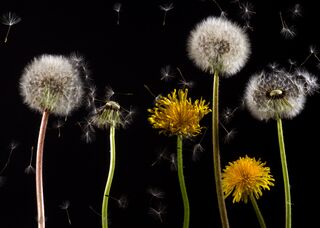Resilience
How to Tell If You're Highly Sensitive
New sensitivity tests help predict where people land on a sensitivity continuum.
Posted June 26, 2020 Reviewed by Devon Frye

Recently, Michael Pluess and colleagues at Queen Mary University of London (QMUL) published a twin-based study (Assary et al., 2020) which found that "genetic influences accounted for 47 percent of the variation in sensitivity, while non-shared environmental influences and measurement error accounted for the remaining 53 percent of the variance." These findings were published June 3 in Molecular Psychiatry. (See "Genetic Factors Make Some of Us More Sensitive Than Others")
These findings on the heritability of sensitivity were partly based on data collected from a 12-item questionnaire called the "Highly Sensitive Child" (HSC) questionnaire designed by Pluess and his QMUL colleagues to measure varying degrees of sensitivity in children and adolescents (ages 8-18). The HSC was first introduced in a paper (Pluess et al., 2017) published in the journal Developmental Psychology.
Earlier this year, Pluess unveiled a modified version of the original 27-item Highly Sensitive Person Scale (Elaine N. Aron, 1996) called the "HSP-12." This shorter HSP test is a 12-item self-reported questionnaire designed to assess environmental sensitivity in adults (over age 18).
This week, Michael Pluess announced that his team recently launched a website called "SensitivityResearch.com," which features different tests to help children, adolescents, adults, and parents identify where they (or their child) sit on the sensitivity spectrum.
"Our website responds to the growing interest of the general public in understanding their sensitivity," Pluess said in a June 25 news release. "Whilst there is a considerable amount of information already available online, the issue is that many of the tests provided aren't reliable. The questionnaire we provide is based on extensive research and has been developed and refined over time, so people can trust the results they receive."
This new Sensitivity Research website offers free and anonymous 12-item sensitivity tests for adults (18+), a self-test for children and adolescents (8-18 years), and a test for parents to identify where their child lands on the sensitivity continuum. All responses to these three different tests use a 7-point Likert scale that ranges from 1, meaning that you "strongly disagree" to 7, which means you "strongly agree."
For example, on a scale of 1 to 7, how would you respond to these three prompts taken from the self-test for adult sensitivity:
- Are you easily overwhelmed by things like bright lights, strong smells, coarse fabrics, or hearing loud sirens?
- Are you deeply moved by arts and music?
- When you must compete or be observed while performing a task, do you become so nervous or shaky that you do much worse than you would otherwise?
After completing the 12-item test online, you can view your results instantly after giving consent—or declining consent—to have your anonymous test results shared with the academic research team led by Michael Pluess. Either way, your personalized scores are available immediately after completing each test and come with a description of where you (or your child) fall on the "sensitivity continuum," which is divided into three categories: Low ("dandelion"), Medium ("tulip"), or High ("orchid").

What Is the Origin Story of "Orchid Child" (Orkidebarn) and "Dandelion Child" (Maskrosbarn)?
In the mid-2000s, W. Thomas Boyce of the University of California, Berkeley, and University of Arizona's Bruce Ellis published a paper (Boyce & Ellis, 2005) about the context of biological sensitivity that presented an "evolutionary-developmental theory of the origins and functions of stress reactivity." To the best of my knowledge, this paper is the first time that the concept of a resilient "dandelion child" and highly-sensitive "orchid child" was introduced into the parlance of developmental psychology. (See "Why Some Children Are Orchids and Others Are Dandelions")
In their 2005 paper, Boyce and Ellis describe the Scandinavian roots of this plant-based terminology and use flower metaphors to describe varying degrees of sensitivity:
"A Swedish idiomatic expression, maskrosbarn (dandelion child), refers to the capacity of some children, not unlike those with low reactive phenotypes, to survive and even thrive in whatever circumstances they encounter, in much the same way that dandelions seem to prosper irrespective of soil, sun, drought, or rain. Observations of such children have generated, for example, an extensive developmental literature on the phenomenon of resilience, the capacity for positive adaptation despite experiences of significant adversity. A contrasting Swedish neologism, orkidebarn (orchid child), might better describe the context-sensitive individual, whose survival and flourishing is intimately tied, like that of the orchid, to the nurturant or neglectful character of the ambient environment. In conditions of neglect, the orchid promptly declines, while in conditions of support and nurture, it is a flower of unusual delicacy and beauty."
A few years ago, Pluess and colleagues published a study (Lionetti et al., 2018) in Translational Psychiatry, "Dandelions, Tulips, and Orchids: Evidence for the Existence of Low-Sensitive, Medium-Sensitive, and High-Sensitive Individuals." As the paper's title elucidates, this study added "tulips" to the mix as a third floral metaphor that is now used to represent "medium sensitivity" on a continuum.
The authors explain the genesis of using "tulips" to describe medium sensitivity: "While we were able to identify a highly sensitive (orchids, 31 percent) and a low-sensitive group (dandelions, 29 percent), we also detected a third group (40 percent) characterized by medium sensitivity, which we refer to as 'tulips' in keeping with the flower metaphor." In the horticultural world, tulips are less delicate than orchids, but they're not as robust or resilient as dandelions.
The primary goal of the new (2020) Sensitivity Research website is to educate the public and give people insights into how someone's sensitivity might play out in the real world.
"Understanding how sensitive you are can be important for helping you to cope in different situations," Pluess said in the news release. "For example, whilst highly sensitive people are more likely to struggle under stressful circumstances, they are also especially receptive to positive and supportive experiences. Whereas those who are low in sensitivity tend to be more resilient when facing adversity but may also benefit less from positive experiences."
In addition to being a universal tool for anyone in the general public, this new online platform is also a resource for clinical researchers and practitioners. The website offers a free membership that gives access to a wide range of validated and approved sensitivity measures. Cost-free memberships to the Sensitivity Research platform are open to all researchers, practitioners, or any interested person from the general public.
Who paid for this website? The Jacobs Foundation in Switzerland—which is a non-profit dedicated to supporting research projects around the world that foster positive development in young people—provided funding for the development of SensitivityResearch.com.
DISCLAIMER: These sensitivity tests are not intended to diagnose or negate a previous diagnosis of any sensitivity-related condition. Also, the outcome of sensitivity tests can vary depending on factors such as age, gender, and other environmental or cultural influences.
Facebook/LinkedIn image: AJR_photo/Shutterstock
References
Elham Assary, Helena M. S. Zavos, Eva Krapohl, Robert Keers, Michael Pluess. "Genetic Architecture of Environmental Sensitivity Reflects Multiple Heritable Components: A Twin Study With Adolescents." Molecular Psychiatry (First published: June 03, 2020) DOI: 10.1038/s41380-020-0783-8
Michael Pluess, Elham Assary, Francesca Lionetti, Elham Lester, Eva Krapohl, Elaine N. Aron, Arthur Aron. "Environmental Sensitivity in Children: Development of the Highly Sensitive Child Scale and Identification of Sensitivity Groups." Developmental Psychology (First published online: September 25, 2017) DOI: 10.1037/dev0000406
Francesca Lionetti, Arthur Aron, Elaine N. Aron, G. Leonard Burns, Jadzia Jagiellowicz & Michael Pluess. "Dandelions, Tulips, and Orchids: Evidence for the Existence of Low-Sensitive, Medium-Sensitive, and High-Sensitive Individuals." Translational Psychiatry (First published: January 22, 2018) DOI: 10.1038/s41398-017-0090-6
W. Thomas Boyce and Bruce J. Ellis. "Biological Sensitivity to Context: I. An Evolutionary-Developmental Theory of the Origins and Functions of Stress Reactivity.” Development and Psychopathology (First published: February 2005) DOI: 10.10170S0954579405050145




